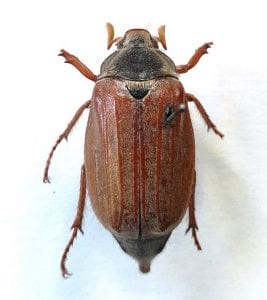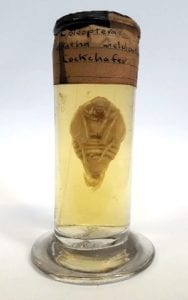Specimen of the Week 293: The Cockchafer
By zcqsrti, on 26 May 2017
Behold. What divine wings of clumsy bumbletude are brought in on the wind? Mitchamador
Hark. Who buzzes and squeaks betwixt the trees? An Oak-wib
Prod? It is I who takes rest beneath this loamy soil. The Snartlegog
This week’s specimen is…
~~The Cockchafer~~
The cockchafer has many names to its legacy and is most notably called a ‘doodlebug’, a nickname later given to the V-1 flying bomb of WWII for their similarities in sound made during flight.
This large bumbling species of beetle feeds on nectar and oak leaves, and has an erratic, clumsy way of getting about in the air; individuals are hefty, ranging in size from 20 to 30 mm. There are a total of three cockchafer species, all categorised to the same genus, Melolontha. The chafers themselves are closely related to scarab beetles, both being members of the family Scarabaeidae, a group that comprises around 30,000 known species.
Cockchafers are a vibrant golden colour, singed by hues of iridescent greens and blues, in particular, the antennae are an impressively flamboyant display, reminiscent of feathers. Our fluid specimen is the epitome of cockchafer pulchritude, featuring beiges flanked by a wonderful puce, all topped off with a briny yellow liquid that is simply divine.
Cockchafers are an agricultural pest with an impressive appetite. During the Middle Ages, it was hard to protect the year’s harvest from hungry beetles and ingenious methods of pest control were common. In the early 14th century, the city of Avignon in southern France put the entire cockchafer species on trial, ordering for them to refrain from plaguing crops and to exile themselves to a specific reserve. Surprisingly the beetles didn’t comply and they were subsequently outlawed, detained and killed. It’s currently cockchafer season right now (another name for them is May bugs), and individuals will be flitting about throughout this spring in search of oaks. They tend to be attracted to light, and will readily fly through windows in the evening for a quick cuddle.

Cockchafer preparing for a particularly clumsy, yet inspiring takeoff. Image by user: Rasbak via Wikimedia Commons; CC BY-SA 3.0
On a final note, of course the famed Nikola Tesla harnessed the unbounded energy of the cockchafer, and as a young child developed a machine of great power. This formidable machine, comparable to none other than the rumored fully functional death beam he used to pay off his hotel bills in later life, was a Frankensteinian device of cockchafers:
“I seem to have acted under the first instinctive impulse which later dominated me – to harness the energies of nature to the service of man. I did this thru the medium of May-bugs … I would attach as many as four of them to a crosspiece, rotably arranged on a thin spindle, and transmit the motion of the same to a large disc and so derive considerable “power” … All went well until a strange boy came to the place. He was the son of a retired officer in the Austrian Army. That urchin ate May-bugs alive and enjoyed them as tho they were the finest blue-point oysters.”
Rowan Tinker is the Museum Intern at the Grant Museum of Zoology, UCL.
2 Responses to “Specimen of the Week 293: The Cockchafer”
- 1
-
2
Stephen Colman wrote on 20 June 2022:
Found 0ne in my garden, most surprised. As i live in Wales, where Sheep and Dragons are the most appropiate wild life.
 Close
Close




[…] UCL: Museum & Collections Blog: Specimen of the Week 293: The Cockchafer […]